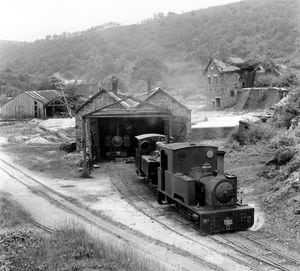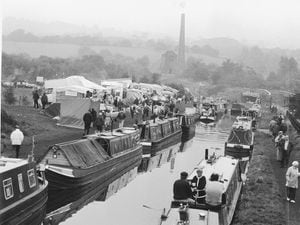Disappeared rail line which still fascinates
andy.cuckson@yahoo.com

Today there are a dwindling amount of visible remains which continue to draw railway enthusiasts to a corner of Shropshire to get a glimpse of where a long-disappeared industrial railway ran, and the mine and the country it served.
And despite money spent restoring mining remains in the Snailbeach area, there is no prospect of the old line being revived.
"A new railway could never reach the old terminus at Snailbeach, and this would hardly be interesting," says Andy Cuckson, whose fascination with the old line began when barely in his teens.
"Snailbeach, in any case, could not cope with the stream of visitors that a tourist railway can attract. The Snailbeach line has gone forever."
Gone, maybe, but the line, its story, and its personalities are remembered in all their glory in Andy's new book, The Snailbeach District Railways, which he intends to be the definitive work on the subject.
He first heard about the line as a 13-year-old boy with the model railway bug growing up in Essex. Its name was so exotic, he thought, that it almost could not be true. Nor had he any idea where it was. Then, over Whitsun in 1971, he visited Snailbeach for the first time, exploring and recording as much as he could of the mine and the railway down to Pontesbury. It was though to be many years before he began any serious research.
In writing the book, he says, his aim has been that the residents of Snailbeach and the district will have a scrupulously factual account of their old railway.
Published by Twelveheads Press (www.twelveheads.com), it includes many previously unpublished photographs.
The line was a narrow gauge railway serving the local mines. It never carried passengers - not officially, anyway, although there were occasions of folk hitching a lift.
It ran for 82 years, with traffic on the railway continuing until 1959. Surprisingly the company still exists, on paper.
Andy, who lives now in Surrey, said that as he tried to learn more about the Snailbeach line, he dipped into a booklet written about it, but it was short, very sketchy and left a lot unsaid.
"My particular driving interest in researching and writing about the railway was that it served a lead mine, and I really wanted to know what it did and how it did that. The booklet didn't say much about that part of its history at all - it was a mystery.
"I first visited Snailbeach and what was left of the line in 1971, aged 15. I have visited it a good number of times since, even though I live a long way away.
"There is very little that is obvious left now to show there was once a railway, unless you know where to look. Most of it is private property, but some lengths of track bed are now public paths.
"The Snailbeach mine has some old sidings still in place and the old locomotive shed is there, and all of that is managed by the Shropshire Mines Trust for the county council which I believe owns it."
He began serious research in 1993, consulting various archive sources.
"Also, local people were very friendly and helpful, and told me a lot of things about how the line was worked and the people who worked it.
"One especially interesting discovery was that a quarry line, which fed stone traffic to the Snailbeach railway between 1906 and 1921, wasn't a 'branch line' of the main railway in the usual sense, as had been written before, but was actually a privately-owned tramway, although it was true that the lines were connected and wagons ran from one line onto the other.
"Also, it could be guessed, by the steep slopes of the route, that the same quarry line was cable-worked using a stationary winding engine. But it was a surprise to find that it used an unusual and ingenious haulage system with that stationary engine, which nobody could have discovered without exploring the route and uncovering a bit of industrial archaeology.
"There are precious few photographs of the line any earlier than the 1920s. It would be great if some turned up, but somehow I doubt that any will."
Andy added: "It is relatively easy to see the mining remains at Snailbeach, now that important derelict buildings have been stabilised and the vegetation is under control, and there is plenty of public information to guide visitors.
"Unfortunately through this 'management' much of the atmosphere has been lost, the main spoil heap has been removed, and various buildings, for example the locomotive shed, do not look as they should. To see things as they were, photographs must be relied on.
"Nevertheless, the mine is worth a visit to get a first hand idea of the mine and the railway working together."
* "The Snailbeach District Railways" is hardback, 218 pages, with 273 illustrations, and costs £30, available from some bookshops or post-free direct from Twelveheads Press, 2 Woodside Cottages, Chacewater, Truro, TR4 8LP.





